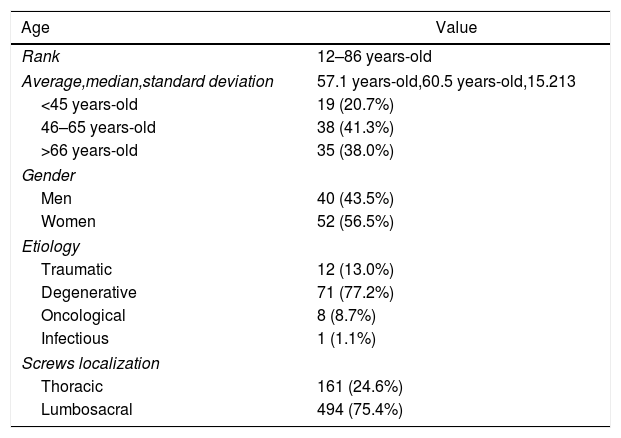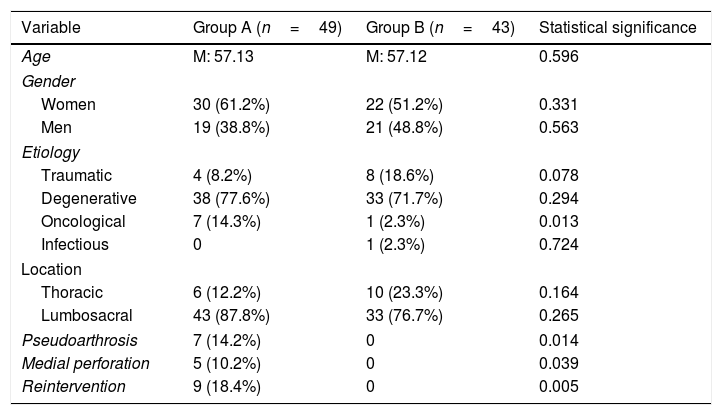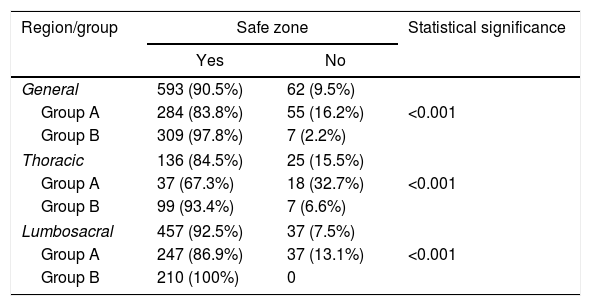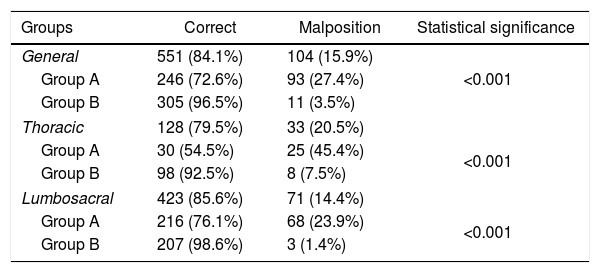Spinal instrumentation using transpedicular screws has been used for decades to stabilize the spine. In October 2018, an intraoperative CT system was acquired in the Neurosurgery service of the University Hospital Complex of Vigo, this being the first model of these characteristics in the Spanish Public Health System, so we began a study from January 2015 to December 2019 to assess the precision of the transpedicular screws implanted with this system compared with a control group performed with the classical technique and final fluoroscopic control.
MethodsThe study was carried out in patients who required transpedicular instrumentation surgery, in total 655 screws were placed, 339 using the free-hand technique (Group A) and 316 assisted with intraoperative CT navigation (Group B) (p>0.05). Demographic characteristics, related to surgery and the screw implantation grades were assessed using the Gertzbein–Robbins classification.
Results92 patients were evaluated, between 12 and 86 years (average: 57.1 years). 161 thoracic screws (24.6%) and 494 lumbo-sacral screws (75.4%) were implanted. Of the thoracic screws, 33 produced a pedicle rupture. For the lumbo-sacral screws, 71 have had pedicle violation. The overall correct positioning rate for the free-hand group was 72.6% and for the CT group it was 96.5% (p<0.05).
ConclusionThe accuracy rate is higher in thoracic-lumbar instrumentation in the navigation group versus free-hand group with fluoroscopic control.
La instrumentación espinal con tornillos transpediculares se ha utilizado durante décadas para estabilizar la columna. En octubre de 2018 se adquirió un sistema de TC intraoperatoria en el Servicio de Neurocirugía del Complejo Hospitalario Universitario de Vigo, siendo este, el primer modelo de estas características en el Sistema Público de Salud español, por lo que iniciamos un estudio desde enero de 2015 a diciembre de 2019 para evaluar la precisión de los tornillos transpediculares implantado con este sistema frente a un grupo control realizado con la técnica clásica y control fluoroscópico final.
MétodosSe realizó un estudio con pacientes que requirieron cirugía de instrumentación transpedicular, en total se colocaron 655 tornillos, 339 con la técnica free-hand (grupo A) y 316 asistidos con navegación por TC intraoperatoria (grupo B) (p>0,05). Se evaluaron las características demográficas relacionadas con la cirugía y los grados de implantación de tornillos según la clasificación de Gertzbein-Robbins.
ResultadosSe evaluaron 92 pacientes, entre 12 y 86 años (promedio: 57,1 años). Se implantaron 161 tornillos torácicos (24,6%) y 494 tornillos lumbosacros (75,4%). De los tornillos torácicos, 33 produjeron una rotura pedicular. En el caso de los tornillos lumbosacros, 71 tuvieron violación pedicular. La tasa de correcto posicionamiento en general para el grupo free-hand fue del 72,6% y para el grupo de TC fue del 96,5% (p<0,05).
ConclusiónLa tasa de precisión es mayor en la instrumentación torácica-lumbar en el grupo de navegación que en el grupo de manos libres con control fluoroscópico.
Article

If it is the first time you have accessed you can obtain your credentials by contacting Elsevier Spain in suscripciones@elsevier.com or by calling our Customer Service at902 88 87 40 if you are calling from Spain or at +34 932 418 800 (from 9 to 18h., GMT + 1) if you are calling outside of Spain.
If you already have your login data, please click here .
If you have forgotten your password you can you can recover it by clicking here and selecting the option ¿I have forgotten my password¿.















